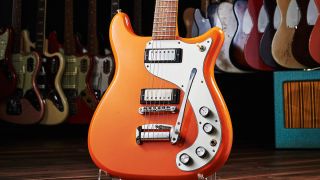While we were putting together our tribute to 70 years of the Les Paul, I asked Gibson’s senior director of product development, Mat Koehler, what his favourite pickups for Les Pauls were. While acknowledging the allure of the fabled PAF, he named the humble mini-humbucker as his favourite, underrated tonemaker.
“It’s just a very specific sweet tone that I really enjoy,” he mused. “And a lot of the great recordings of the ’70s and beyond were done on mini-humbuckers – and you just don’t realise it.”
Not to be confused with the similar-looking Firebird pickup, which was constructed by winding coils round two bar magnets mounted edgewise on a baseplate, the mini-humbucker, as its name suggests, was somewhat truer to the concept of a downsized standard ’bucker. Like its full-size brethren, the Gibson mini-humbucker featured an Alnico bar magnet laid flat on a nickel-silver baseplate at the base of the pickup, with two unpotted coils mounted on top.
One coil featured adjustable nickel-steel pole screws to conduct the magnet’s field upwards towards the strings. The other coil, less conventionally, featured a bar-like slug of steel, mounted edgewise, at its centre. This also served to conduct the underlying magnet’s field upwards through the coil, though unlike the screw poles it was non-height-adjustable. Typically, DC resistance was between 6 and 7kohms, only a tad cooler than the average PAF.

So far, so interesting. But why, with a successful full-size humbucker and P-90s to play with, did Gibson feel the need to produce a third mainstream pickup design? The mini-humbucker was sonically brighter and crisper than either a PAF or a P-90, but was that the main reason it was developed? Mat Koehler picks up the story, which, as was so often the case, had commercial not sonic imperatives behind it.
It was very important to them both that Epiphone was distinct from Gibson in as many ways as possible... mini-humbuckers were one way that they could make their models distinct
Mat Koehler, Gibson
“The story there is that when Gibson purchased Epiphone, the idea was that they could now find new markets outside of Gibson dealers. They could find dealers in competitive areas that wouldn’t sell Gibson against Gibson, so they created the Epiphone brand, basically, as an offshoot of Gibson,” Mat explains.
“It was also approached more as [a project led by specific individuals]. So it was Ward Arbanas who was leading Epiphone and then the mind behind the new models was Andy Nelson, one of their performers and salespeople who did all the Gibson clinics and things. So that was how those designs came about.
“But it was very important to them both that Epiphone was distinct from Gibson in as many ways as possible. [Epiphone instruments were] made in the same factories alongside the Gibsons as we know, but mini-humbuckers were one way that they could make their models distinct.
“So they came about originally, I believe, as a proprietary request from Harmony in Chicago because it was the same parent company, and they eventually went on the Silvertone 1446 model – another mini-humbucker with the same casing and the only difference was the staggered polepieces.
“But I mean, it’s a mini-humbucker through and through, it’s just kind of constructed a little bit differently from the Gibson style. So I think that was the impetus for saying, ‘All right, well, we’ve already gotten this far. Let’s just have a proprietary humbucker for Epiphone.”

All change
And so it was that the mini-humbucker graced elegant semis such as the Sorrento and Riviera plus Epiphone’s toneful solid-body Coronet (from 1963), partly fulfilling the goal of giving Epiphone a distinctive sound and features to sell to customers. However, as Epiphone player John Lennon once observed, “Life’s what happens while you’re making other plans.”
Introduced as a unique selling point for Epiphones, the mini-humbucker concept eventually had to perform a complete U-turn at the end of the ’60s as Japanese copies of US guitars began eating away at Gibson’s market share.
“You only see the mini-humbucker on Epiphones, then… Gibson sales dropped and they started talking about moving Epiphone [manufacturing] internationally so they could compete with some of the pop-up Japanese makers and whatnot. But they still had this huge inventory of mini-humbuckers.
“So they had designed the 1968 Les Paul Standard – which was a Goldtop, but they were calling it a Standard – with P-90s. But I think, again, [it became about] factory needs and somebody said, ‘Hey, we have all this inventory, it fits in the same rout as a P-90. Can you guys use that up?’”
In a classic piece of psychological misdirection, the new Les Pauls equipped with surplus mini-humbuckers were named ‘Deluxe’ models, though in what sense they represented an upmarket progression from the previous P-90 ‘Standards’ wasn’t clear. And, in a way, it didn’t matter too much as they did offer a distinctive new voice for the Les Paul.
The story goes that Scott Gorham of Thin Lizzy, on being instructed to equip himself with a ‘proper’ electric guitar, sought out a used Les Paul among London’s music stores. Finding used ’Bursts and Customs too expensive, he picked up a Deluxe instead. Looking back, one would have to say that his unique wiry tone wouldn’t have sounded anything like so distinctive had he got his first wish.
“That’s honestly how the Les Paul Deluxe came about,” Mat reflects. “The need to use up inventory of mini-humbuckers – which is funny because they suit a Les Paul Deluxe so well. And like I said, it’s a really specific sound. I like the sound of an Epiphone Riviera with a mini-humbucker because of the sweetness and with the Les Paul I think what you add is even more sustain and clarity, which is a great quality to have in a pickup,” he concludes.

